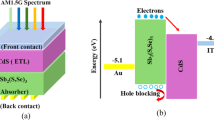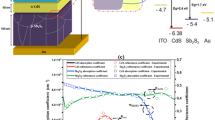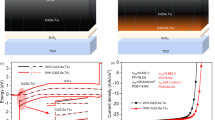Abstract
Antimony selenosulfide (Sb2(S,Se)3) solar cells suffer from charge carrier loss, which has limited the power conversion efficiency to around 10%. Here we develop a charge carrier management strategy using a textured fluorine-doped tin oxide substrate as the front contact to enhance light scattering and maximize charge generation. To overcome voids and shunt paths introduced by the textured surface, we insert a SnO2 layer by atomic layer deposition at the textured fluorine-doped tin oxide/CdS interface. This results in a conformal deposition of CdS and an optimal bandgap profile in the Sb2(S,Se)3 absorber, which improves charge transport and lowers charge recombination at the interface and in the bulk, respectively. We achieve a certified efficiency of 10.70% sodium selenosulfate-based Sb2(S,Se)3 solar cells with excellent stability. We prove the generality of the method demonstrating selenourea-based Sb2(S,Se)3 and upscaling the solar cells to 1 cm2. The results represent a step forward in the development of antimony-based solar cells.
This is a preview of subscription content, access via your institution
Access options
Access Nature and 54 other Nature Portfolio journals
Get Nature+, our best-value online-access subscription
$32.99 / 30 days
cancel any time
Subscribe to this journal
Receive 12 digital issues and online access to articles
$119.00 per year
only $9.92 per issue
Buy this article
- Purchase on SpringerLink
- Instant access to full article PDF
Prices may be subject to local taxes which are calculated during checkout




Similar content being viewed by others
Data availability
All data generated or analysed during this study are included in the published article and its Supplementary Information. Additional data are available from the corresponding authors on request. Source data are provided with this paper.
References
Liu, S. et al. Buried interface molecular hybrid for inverted perovskite solar cells. Nature 632, 536–542 (2024).
Keller, J. et al. High-concentration silver alloying and steep back-contact gallium grading enabling copper indium gallium selenide solar cell with 23.6% efficiency. Nat. Energy 9, 467–478 (2024).
Green, M. A. et al. Solar cell efficiency tables (version 65). Prog. Photovolt. Res. Appl. 33, 3–15 (2025).
Shi, J. et al. Multinary alloying for facilitated cation exchange and suppressed defect formation in kesterite solar cells with above 14% certified efficiency. Nat. Energy 9, 1095–1104 (2024).
Tang, R. et al. Hydrothermal deposition of antimony selenosulfide thin films enables solar cells with 10% efficiency. Nat. Energy 5, 587–595 (2020).
Zhou, Y. et al. Thin-film Sb2Se3 photovoltaics with oriented one-dimensional ribbons and benign grain boundaries. Nat. Photon. 9, 409–415 (2015).
Kondrotas, R. et al. Sb2S3 solar cells. Joule 2, 857–878 (2018).
Wang, X. et al. Upper efficiency limit of Sb2Se3 solar cells. Joule 8, 2105–2122 (2024).
Chen, C. et al. Open-circuit voltage loss of antimony chalcogenide solar cells: status, origin, and possible solutions. ACS Energy Lett. 5, 2294–2304 (2020).
Qian, C. et al. Bifacial and semitransparent Sb2(S,Se)3 solar cells for single-junction and tandem photovoltaic applications. Adv. Mater. 35, 2303936 (2023).
Wang, W. et al. Over 6% certified Sb2(S,Se)3 solar cells fabricated via in situ hydrothermal growth and postselenization. Adv. Electron. Mater. 5, 1800683 (2019).
Zhao, Y. et al. Innovative in situ passivation strategy for high-efficiency Sb2(S,Se)3 solar cells. Adv. Mater. 36, 2410669 (2024).
Dong, J. et al. Low-cost antimony selenosulfide with tunable bandgap for highly efficient solar cells. Small 19, 2206175 (2023).
Liu, C. et al. Heterojunction lithiation engineering and diffusion-induced defect passivation for highly efficient Sb2(S,Se)3 solar cells. Energy Environ. Sci. 17, 8402–8412 (2024).
Zhou, J. et al. Control of the phase evolution of kesterite by tuning of the selenium partial pressure for solar cells with 13.8% certified efficiency. Nat. Energy 8, 526–535 (2023).
Jehl, Z. et al. Thinning of CIGS solar cells: part II: cell characterizations. Thin Solid Films 519, 7212–7215 (2011).
Bothwell, A. M. et al. Performance analysis of 0.4–1.2-μm CdTe solar cells. IEEE J. Photovolt. 10, 259–266 (2020).
Chen, Z. et al. The effect of absorber thickness on the planar Sb2S3 thin film solar cell: trade-off between light absorption and charge separation. Sol. Energy 201, 323–329 (2020).
Kambe, M. et al. Fabrication of A-Si:H solar cells on high haze SnO2:F thin films. In 2008 33rd IEEE Photovoltaic Specialists Conference 1–4 (IEEE, 2008).
Kim, M. et al. Conformal quantum dot-SnO2 layers as electron transporters for efficient perovskite solar cells. Science 375, 302–306 (2022).
Ge, Y. et al. Suppressing wide-angle light loss and non-radiative recombination for efficient perovskite solar cells. Nat. Photon. 19, 170–177 (2025).
Isabella, O. et al. Modulated surface textures for enhanced light trapping in thin-film silicon solar cells. Appl. Phys. Lett. 97, 101106 (2010).
Tamang, A. et al. Light-trapping and interface morphologies of amorphous silicon solar cells on multiscale surface textured substrates. IEEE J. Photovolt. 4, 16–21 (2014).
Jin, X. et al. Controllable solution-phase epitaxial growth of Q1D Sb2(S,Se)3/CdS heterojunction solar cell with 9.2% efficiency. Adv. Mater. 33, 2104346 (2021).
Cao, Z. et al. Anomalous electron doping in CdS to promote the efficiency improvement in Sb2Se3 thin film solar cells. Adv. Funct. Mater. 35, 2418974 (2025).
Li, J. et al. Hydrazine hydrate-induced surface modification of CdS electron transport layer enables 10.30%-efficient Sb2(S,Se)3 planar solar cells. Adv. Sci. 9, 2202356 (2022).
Zhao, Y. et al. Zinc-based electron transport materials for over 9.6%-efficient S-rich Sb2(S,Se)3 solar cells. J. Mater. Chem. A 9, 12644–12651 (2021).
Waleed, A. et al. Performance improvement of solution-processed CdS/CdTe solar cells with a thin compact TiO2 buffer layer. Sci. Bull. 61, 86–91 (2016).
Kartopu, G. et al. Enhancement of the photocurrent and efficiency of CdTe solar cells suppressing the front contact reflection using a highly-resistive ZnO buffer layer. Sol. Energy Mater. Sol. Cells 191, 78–82 (2019).
Naghavi, N. et al. Buffer layers and transparent conducting oxides for chalcopyrite Cu(In,Ga)(S,Se)2 based thin film photovoltaics: present status and current developments. Prog. Photovolt. Res. Appl. 18, 411–433 (2010).
Yao, Y. et al. Achieving over 860 mV open-circuit voltage in low-Ag wide-bandgap Cu(In,Ga)Se2 solar cells through ion diffusion and band structure optimization. Adv. Funct. Mater. https://doi.org/10.1002/adfm.202423228 (2025).
Rau, U. et al. Electronic properties of ZnO/CdS/Cu(In,Ga)Se2 solar cells-aspects of heterojunction formation. Thin Solid Films 387, 141–146 (2001).
Ishizuka, S. et al. Fabrication of wide-gap Cu(In1−xGax)Se2 thin film solar cells: a study on the correlation of cell performance with highly resistive i-ZnO layer thickness. Sol. Energy Mater. Sol. Cells 87, 541–548 (2005).
Tseng, P. C. et al. Angle-resolved characteristics of silicon photovoltaics with passivated conical-frustum nanostructures. Sol. Energy Mater. Sol. Cells 95, 2610–2615 (2011).
Lv, K. et al. Effect of thickness and Se distribution of Sb2S3−ySey thin films to solar cell efficiency. Mater. Today Energy 36, 101367 (2023).
Zhao, Y. et al. Regulating energy band alignment via alkaline metal fluoride assisted solution post-treatment enabling Sb2(S,Se)3 solar cells with 10.7% efficiency. Adv. Energy Mater. 12, 2103015 (2022).
Dong, J. et al. Lowest open-circuit voltage deficit achievement to attain high efficient antimony selenosulfide solar cells. Adv. Funct. Mater. 34, 2309764 (2024).
Neupane, S. et al. Ex situ bismuth doping for efficient CdSeTe thin-film solar cells with open-circuit voltages exceeding 900 mV. Joule 9, 101766 (2025).
Luo, D. et al. Minimizing non-radiative recombination losses in perovskite solar cells. Nat. Rev. Mater. 5, 44–60 (2020).
Zhu, J. et al. A donor-acceptor-type hole-selective contact reducing non-radiative recombination losses in both subcells towards efficient all-perovskite tandems. Nat. Energy 8, 714–724 (2023).
Wang, W. et al. Double interface modification promotes efficient Sb2Se3 solar cell by tailoring band alignment and light harvest. J. Energy Chem. 70, 191–200 (2022).
Yu, H. et al. Superfast room-temperature activation of SnO2 thin films via atmospheric plasma oxidation and their application in planar perovskite photovoltaics. Adv. Mater. 30, 1704825 (2018).
Paik, M. J. et al. Ultrafine SnO2 colloids with enhanced interface quality for high-efficiency perovskite solar cells. Joule 8, 2073–2086 (2024).
Gao, D. et al. Long-term stability in perovskite solar cells through atomic layer deposition of tin oxide. Science 386, 187–192 (2024).
Park, S. M. et al. Low-loss contacts on textured substrates for inverted perovskite solar cells. Nature 624, 289–294 (2023).
Lan, Z. et al. Homogenizing the electron extraction via eliminating low-conductive contacts enables efficient perovskite solar cells with reduced up-scaling losses. Adv. Funct. Mater. 34, 2316591 (2024).
Lian, W. et al. Probing the trap states in n–i–p Sb2(S,Se)3 solar cells by deep-level transient spectroscopy. J. Chem. Phys. 153, 124703 (2020).
Lian, W. et al. Distinctive deep-level defects in non-stoichiometric Sb2Se3 photovoltaic materials. Adv. Sci. 9, 2105268 (2022).
Huang, M. et al. Complicated and unconventional defect properties of the quasi-one-dimensional photovoltaic semiconductor Sb2Se3. ACS Appl. Mater. Interfaces 11, 15564–15572 (2019).
Wang, J. et al. Pd(II)/Pd(IV) redox shuttle to suppress vacancy defects at grain boundaries for efficient kesterite solar cells. Nat. Commun. 15, 4344 (2024).
Shen, G. et al. Strong chelating additive and modified electron transport layer for 8.26%-efficient Sb2S3 solar cells. Adv. Energy Mater. https://doi.org/10.1002/aenm.202406051 (2025).
Gu, Y. et al. Solvent annealing enabling reconstruction of cadmium sulfide film for improved heterojunction quality and photovoltaic performance of antimony selenosulfide solar cells. Adv. Funct. Mater. 34, 2311577 (2024).
Chen, G. et al. Suppressing buried interface nonradiative recombination losses toward high-efficiency antimony triselenide solar cells. Adv. Mater. 36, 2308522 (2024).
Ding, Y. et al. Single-crystalline TiO2 nanoparticles for stable and efficient perovskite modules. Nat. Nanotechnol. 17, 598–605 (2022).
Gong, X. et al. Highly efficient perovskite solar cells with gradient bilayer electron transport materials. Nano Lett. 18, 3969–3977 (2018).
Shi, J. et al. From ultrafast to ultraslow: charge-carrier dynamics of perovskite solar cells. Joule 2, 879–901 (2018).
Yin, K. et al. Gradient bandgaps in sulfide kesterite solar cells enable over 13% certified efficiency. Nat. Energy 10, 105–214 (2025).
Liang, X. et al. Reduction of bulk and interface defects via photo-annealing treatment for high-efficiency antimony selenide solar cells. Energy Environ. Sci. 17, 9499–9508 (2024).
Li, Z. et al. 9.2%-efficient core-shell structured antimony selenide nanorod array solar cells. Nat. Commun. 10, 125 (2019).
Wen, X. et al. Vapor transport deposition of antimony selenide thin film solar cells with 7.6% efficiency. Nat. Commun. 9, 2179 (2018).
Zhang, Y. et al. Selenium-graded Sb2(S1-xSex)3 for planar heterojunction solar cell delivering a certified power conversion efficiency of 5.71%. Sol. RRL 1, 1700017 (2017).
Chen, C. et al. 6.5% certified efficiency Sb2Se3 solar cells using PbS colloidal quantum dot film as hole-transporting layer. ACS Energy Lett. 2, 2125–2132 (2017).
Chen, S. et al. A codoping strategy for efficient planar heterojunction Sb2S3 solar cells. Adv. Energy Mater. 12, 2202897 (2022).
Che, B. et al. Post-deposition treatment of Sb2Se3 enables defect passivation and increased carrier transport dimension for efficient solar cell application. Angew. Chem. Int. Ed. 64, e202425639 (2025).
Shi, X. et al. Nanorod-textured Sb2(S,Se)3 bilayer with enhanced light harvesting and accelerated charge extraction for high-efficiency Sb2(S,Se)3 solar cells. Chem. Eng. J. 437, 135341 (2022).
Wang, L. et al. Stable 6%-efficient Sb2Se3 solar cells with a ZnO buffer layer. Nat. Energy 2, 17046 (2017).
Acknowledgements
This work is supported by the National Key Research and Development Program of China (grant number 2024YFB4205300, Y.Z.), the National Natural Science Foundation of China (grant number U1902218, Y.Z.). This work is supported by the National Natural Science Foundation of China (grant number 22275180, T.C.) and the Fundamental Research Funds for the Central Universities (grant number WK2490000002, T.C.). We thank D. M. Li from Institute of Physics, Chinese Academy of Sciences for M-TPC/TPV test support and helpful discussions and X. Lou from Instrumentation and Service Center for Molecular Sciences at Westlake University for ARR measurements and helpful discussions.
Author information
Authors and Affiliations
Contributions
J.D. and Y.Z. conceived of the original concept and designed the experiments. J.D., H.L. and Q.G. fabricated the devices and conducted the photovoltaic and optical characterization and analysis. J.Y., R.T., Jianyu Li and T.C. did the O-DLTS and TAS measurements and performed the analysis. Z.C., Y.L., H.X., R.M., Jianpeng Li, X.X. and Z.Z. assisted with the device fabrication, characterization and discussions. P.Z., T.L. and L.W. did the Rietveld analysis. W.W. participated in the GIXRD data analysis and provided constructive suggestions for refining the data analysis. J.D. and Y.Z. co-wrote the paper. Y.Z., L.W., T.C. and S.(F.)L. revised the paper with all authors commenting on the paper.
Corresponding authors
Ethics declarations
Competing interests
The authors declare no competing interests.
Peer review
Peer review information
Nature Energy thanks Guojia Fang and the other, anonymous, reviewer(s) for their contribution to the peer review of this work.
Additional information
Publisher’s note Springer Nature remains neutral with regard to jurisdictional claims in published maps and institutional affiliations.
Supplementary information
Supplementary Information
Supplementary Figs. 1–61, Notes 1–10, Tables 1–15 and Refs. 1–15.
Supplementary Data 1
Supplementary data for Supplementary Figs. 8, 17h, 46, 51 and 53.
Source data
Source Data Fig. 1
Source data for Fig. 1i.
Source Data Fig. 3
Source data for Fig. 3a,b,e.
Rights and permissions
Springer Nature or its licensor (e.g. a society or other partner) holds exclusive rights to this article under a publishing agreement with the author(s) or other rightsholder(s); author self-archiving of the accepted manuscript version of this article is solely governed by the terms of such publishing agreement and applicable law.
About this article
Cite this article
Dong, J., Gao, Q., Wu, L. et al. Carrier management through electrode and electron-selective layer engineering for 10.70% efficiency antimony selenosulfide solar cells. Nat Energy 10, 857–868 (2025). https://doi.org/10.1038/s41560-025-01792-y
Received:
Accepted:
Published:
Issue date:
DOI: https://doi.org/10.1038/s41560-025-01792-y
This article is cited by
-
Unveiling the role of dual grading in device optimization of HTL-free Sb2(S, Se)3 solar cells
Scientific Reports (2025)



